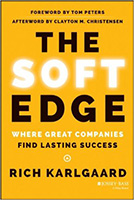The Soft Edge
 In The Soft Edge, Rich Karlgaard looks at how the “soft side” of business actually gives a huge competitive advantage to those who do it well. While mastering the hard side is important, advances in technology tend to level the playing field, and organizations that develop the soft side of things, such as trust, smarts, teamwork, taste, and storytelling, will come out ahead.
In The Soft Edge, Rich Karlgaard looks at how the “soft side” of business actually gives a huge competitive advantage to those who do it well. While mastering the hard side is important, advances in technology tend to level the playing field, and organizations that develop the soft side of things, such as trust, smarts, teamwork, taste, and storytelling, will come out ahead.
Generally, churches seem to be stronger on that side of the ledger, so it was interesting to think about how Karlgaard’s insights apply to a church. Applying them in a business context was easier, or at least more straightforward. But there were two particular things I took from this book:
The first relates to trust. In our day, the church is not a particularly trusted institution. Right or wrong, churches often have a trust deficit in their communities, which certainly hinders their potential impact. How does a church build trust? Avoiding ethical lapses, of course, but that should be a given.
Karlgaard identifies another way: “…demonstrate real concern. We tend to trust people we believe will care about our welfare. So demonstrate to others that you’ll do the right thing for them, even if it’s uncomfortable or it puts you at risk.” This should come naturally to any church, but too often it doesn’t. But I think it would make a significant difference if churches were known in their community as places that really care about people and go beyond what is normal to help people—especially people outside the church.
Seems pretty obvious, churches doing things that churches should be doing. That builds trust, opens doors, and increases impact. It works for businesses; how much more would that work for churches?
Of course, that raises the question, “Why is that so rare?” That’s more than I can dig into in this post, but it’s a question worth asking for every leader. Is my church or organization doing anything that will build trust in my community? If not—why not?
The second thing that struck me was the importance and power of story. A good story will link an idea with an emotion, which is a powerful way to move people to action. No amount of data or persuasive argument can do that the way a good story can, which leads me to think about both how I teach and how I cast vision. It’s immediately apparent to me that I can get a lot better at using stories. I do use them, but I can clearly do more.
Why don’t I? Well, finding the right story takes work—it takes time, energy, and thought, and sometimes it is just easier not to. However, I, like every teacher, want to see people grow and change as a result of what I do. Remembering that motivates me to put the work in to find stories that communicate. It’s not a new idea; it’s just one I need to put into practice more diligently.
So what about you? I’d love to hear what you are doing to build trust or what other takeaways you have from this summary. Let’s all learn from each other!



No Comments